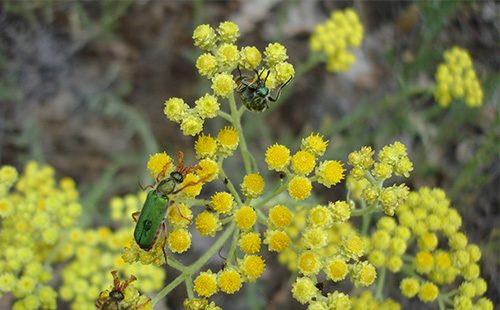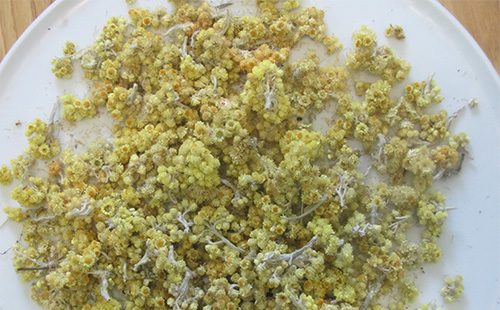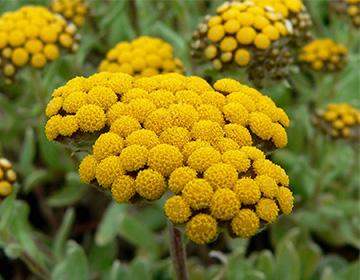The content of the article
The color of the flowers of the herbaceous plant also determined its species name. From the Latin Helichrysum arenarium is translated as "golden sun". The term "immortelle" itself arose due to the ability of a ripped plant to preserve the color of stems and inflorescences for many years. In Russia, small bouquets were usually laid on the windowsill, under the window, so that looking into the courtyard, remember the summer. They rescued the family with many ailments.
Botanical characteristic
The culture belongs to the Astrov family, the family of Tsminov. It is found everywhere in Europe and Asia. In Russia, massive natural plantings prevail in the middle and southern Volga region, southern Siberia, and Ciscaucasia.
The plant is unpretentious to the soil. It develops well on salt and sandy soils, drought-resistant. You can meet him in the steppe, in meadows, clearings, mountain slopes, on the border of forests. He loves the sun, therefore, it is adjacent only to young trees, especially often to pines up to ten years old. Old trees closing the crowns over the grass canopy ruining a sunny flower.
Description
Perennial grass reaches a height of 20-40 cm. It has a short black-brown rhizome, branching in the soil into numerous subordinate roots. Thin and long, they are able to get moisture from the depths of the soil. But the root system is weak, the plant is poorly attached to the ground, therefore, during harvesting due to carelessness, the stems are often removed with roots, which leads to the death of natural plantings.
The stem is straight and straight. Rhizome can give a single stalk, which reaches a maximum height, or several small ones. In this case, the largest dominant stem stands out, it blooms and bears fruit, while smaller ones frame it with small flowers, but they do not give seeds.
The whole aerial part is covered with white, as if felt fluff. Leaves at the base up to 6 cm long and collected in a rosette, which always includes young green and dried brown petals. As the stem grows, the leaves become smaller, grow to only 2 cm, while maintaining an elongated "lanceolate" shape. The whole plant is directed upward towards the sun.
At the end of June, a flowering period begins, lasting until the end of September. Grass releases corymbose panicles from several stems, each of which is crowned with a yellow or orange inflorescence. Flowers are small, in rounded baskets, on one plant there are up to a dozen of them. The largest are located in the center.
Collection and harvesting of raw materials
Helichrysum flowers, which are collected at the beginning of flowering, have pharmacological value.It is important that the baskets do not open completely, otherwise the petals will crumble during drying, but the receptacles themselves are not pharmacological raw materials.
Inflorescences are cut off with scissors, secateurs with a peduncle up to 1 cm long. If you tear off the tops with your hands, be sure to hold the stem so as not to tear it off the root. The plant is able to produce multiple colors in one season. Five to seven days after harvesting, buds reappear on the stem, and this is repeated up to four times. Therefore, the collection of medicinal raw materials is carried out repeatedly.
For every 15-20 m2 up to ten bushes are left untouched, and on one site harvesting is carried out after a year. Such simple principles allow you to save the sand immortelle population. If the areas of its growth are identified in a pine forest, where the crowns are about to close, the raw materials should be collected totally, capturing each bush, since this population is doomed to death.
When drying raw materials should be guided by four recommendations.
- Sprinkle with a thin layer. The raw materials are laid out on newspapers with a layer of no more than 2 cm. On one square there should be no more than a kilogram of inflorescences.
- Dry in the shade. Suitable for this are attic rooms or canopies where access to the sun is excluded. Even the short-term effect of sunlight causes discoloration of the raw materials, which indicates the destruction of the biologically active complex.
- Provide good ventilation. The mass is rich in essential oils, which are concentrated in the place of drying. In addition, it is important to create the right conditions for intensive evaporation of moisture, so the windows in the room should be kept open.
- Maintain a temperature of 40-50aboutWITH. This can be achieved by drying the raw materials in the attic under a metal roof. And also in an automatic drying chamber, which guarantees the best quality of raw materials in comparison with traditional harvesting.
Composition
The beneficial properties of immortelle are determined by its high content of flavonoids. A combination of substances constituting a unique biologically active complex was revealed:
- isosalipurposide;
- naringenin;
- gelichrysins A and B;
- kempferol.
The composition contains essential oil, phthalides, coumarins. Steroids, organic acids, tarry substances (bitterness), polysaccharides and carotenoids are also of pharmacological importance.
Properties
The study of the properties of a medicinal plant in different years was carried out by Soviet specialists. So back in 1929, the researcher M.K. Petrova in laboratory experiments established a versatile effect on the digestive system of the infusion and decoction of flowers:
- increased secretion of bile;
- a change in the viscosity and composition of bile (saturation with bilirubin);
- increased production of gastric, pancreatic juices;
- increased tone of the gallbladder.
Scientist OA A. Rosenfeld noted the ability of immortelle medications to slow intestinal motility, increasing the digestive productivity of the stomach.
4 types of exposure
Some properties of the medicinal plant, noted by traditional medicine, were clarified in the course of modern experiments. Four types of effects of herbal remedies on living organisms are proven.
- Antimicrobial. In folk medicine, the plant is credited with pronounced antibacterial properties against staphylococci and streptococci, due to the content of resinous substances. In the experiment of Turkish specialists G. Kozar and B.Kubuku, whose results were published in the journal Phytotherapy in 1990, has been questioned for its broad antibacterial activity. It has been established that alcoholic extract in high concentration moderately inhibits the growth of Pseudomonas aeruginosa, but is absolutely ineffective against Escherichia coli, rod-shaped bacteria Klebsiella pneumoniae, Salmonella, Shigella, epidermal and Staphylococcus aureus. However, the direct antiviral effect of immortelle sand in the form of an aqueous extract (decoction) on the viruses of herpes type II, influenza A (Influenza A2) and hepatitis B has been established.
- Antispasmodic. All forms of drugs (water, alcohol, dry extracts) have antispasmodic activity and a desirable effect. This conclusion was reached by the Polish researcher A. Jadowska. The specialist noted the primary choleretic effect with moderate antispasmodic.
- Diuretic. Some sources refer to herbal medicine as a diuretic. Studies by European experts in 1962 confirmed this data only partially. It was found that when taken orally, drugs do not affect diuresis. This effect is achieved only with their intravenous administration, which is impractical for therapeutic use.
- Antitumor. The use of culture as an antitumor agent is not considered by science due to its small research base. In 2013, a group of scientists from the Saratov State Medical University named after V. Razumovsky investigated the effect of a group of flavonoids, which are part of the flowers of the Helichrysum, on the tumor process. It was established that the plant extract reduces the intoxication of animals with vaccinated tumors, and also has pronounced antitumor properties in liver cancer and sarcoma.
Therapeutic practice
“The main use of the medicinal plant is in diseases of the liver and pancreas,” says phytotherapist A. Varennikov. - It is applied separately and in fees. In my opinion, using it in training camps is safer. ”
The main dangers of culture, according to A. Varennikov, are the ability to increase pressure with pronounced choleretic action. In drugs, these effects can be adjusted.
Liver, gastrointestinal tract
A description of the practice of treating diseases of the liver and gastrointestinal tract is contained in the works of the classic of Soviet herbal medicine M. Nosal. “For the choleretic purpose, there is no more useful plant in the nature surrounding us,” the herbalist noted in a collection of medicinal plants and their use among the people. - Often its color is associated with the complexion of the patient with jaundice. I used jaundice patients from this plant; for many, the disease went away on the fifth day. ”
M. Nosal noted the healing effect of herbal remedies on the liver and other organs of the digestive system. Recommended drinking immortelle with:
- pancreatitis;
- hepatitis;
- diabetes
- chronic gastritis;
- low acidity of gastric juice;
- cirrhosis of the liver;
- colic.
Worms
Modern medicine does not consider cmin sandy as a remedy for worms, although there is a practice in people of treating acaricidal lesions of the body with the help of herbal remedies. Its description can also be found in the writings of the phytotherapist M. Nosal.
“In many patients that I used for jaundice, worms came out of the intestines,” commented Mikhail Nosal. “The roundworms were painted intense yellow.”
Leather
You can use the plant to treat skin diseases:
- dermatitis;
- eczema
- psoriasis;
- acne.
The alcohol-based product is taken orally, the affected areas are wiped with water infusion to eliminate inflammation, normalize the barrier functions of the skin. It was noted that aqueous solutions act on the affected integument soothingly, stimulate tissue regeneration.

Contraindications
Since the plant is not included in the state pharmacopoeia, its contraindications are not formulated in open sources. Separate information is contained in the writings of herbalists, research papers by scientists and monographs of the World Health Organization (WHO).
So WHO prohibits the use of herbal remedies for obstruction of the biliary tract. Despite the fact that the infusion is recommended by traditional medicine for the removal of small stones, this practice is dangerous, since there is a high risk of displacement of large stones with blockage or rupture of the biliary tract.
“Immortelle drugs have low toxicity,” says herbalist N. Maznev. “But their long-term use can cause congestion in the gallbladder.” Travnik A. Varennikov does not recommend taking them longer than two weeks, and also indicates pregnancy among contraindications.
Prescription Drugs
According to the recommendations of the WHO and the American Botanical Council, the daily dosage should be no more than 3 g of immortelle flowers in the equivalent of a drug prepared on their basis.
Decoction
Features. It is used for digestive disorders associated with impaired gallbladder, liver. It is also recommended for inflammation of the urogenital organs: the bladder, kidneys, when urination causes pain.
How to make and take
- Finely chop 10 g of dried inflorescences.
- Pour in 200 ml room temperature water.
- Cover, place in a water bath.
- Heat until boiling, simmer for 30 minutes, stirring frequently.
- Refrigerate for ten minutes.
- Strain, wring out the inflorescences.
- Bring the resulting volume to 200 ml.
- Take the drug 15 minutes before a meal in a tablespoon three to four times a day.
Infusion
Features. Take in the course of treatment of liver diseases and for the expulsion of worms. The classic recipe was proposed by the herbalist M. Nosal. It is convenient to brew infusion in a thermos. If the container is a glass jar, it should be wrapped in a towel.
How to make and take
- Pour a tablespoon of inflorescences (with a slide) into the container.
- Pour boiling water with a volume of 500 ml.
- Leave to brew for 40 minutes.
- Drink the resulting volume a day in three or four doses, preferably half an hour before meals.
Tincture
Features. Recommended for inflammatory diseases of the digestive and genitourinary systems. Assign inside with psoriasis, eczema, after animal bites. It is stored for a long time, so you do not need to prepare a phytopreparation daily.
How to make and take
- Grind a tablespoon of dried inflorescences.
- Pour in 40-50-degree alcohol with a volume of 250 ml.
- Leave to brew for 14 days in a dark place.
- Shake the container daily.
- Squeeze, strain.
- Take a tablespoon three times a day.

Choleretic collection
Features. Combined agent with a pronounced anti-inflammatory effect. It stimulates bile secretion, facilitates digestion, improves well-being with dyspeptic disorders.
How to make and take
- Mix two parts of mint leaves, coriander fruits, three parts of trefoil leaves and four parts of immortelle inflorescences.
- Take a teaspoon of the resulting mixture.
- Pour into a container, pour boiling water with a volume of 500 ml.
- Leave to infuse for 20 minutes.
- Strain.
- Take in the form of heat half a glass three times a day half an hour before meals.
Do not forget that the course of treatment with immortelle preparations should not exceed ten days due to the risk of stagnation of bile.

